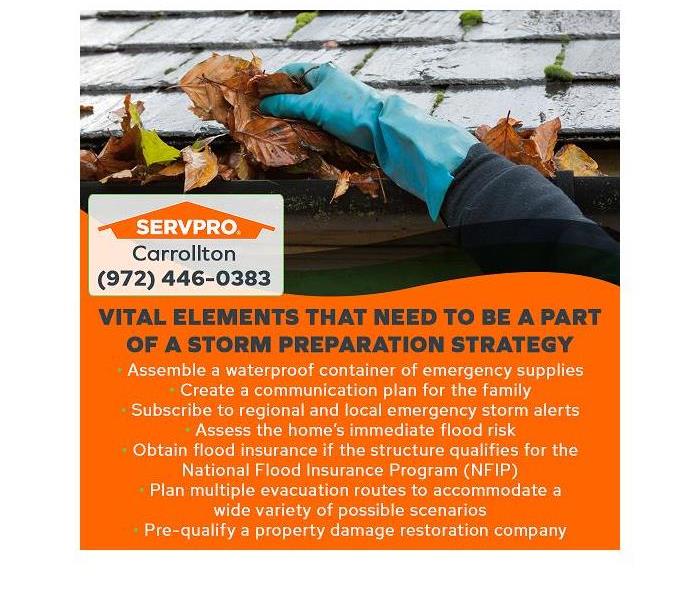Storm Safety Tips to Help Farmers Branch, TX, Homeowners Weather Hurricane Season
4/12/2022 (Permalink)
Blog Summary: With the Atlantic hurricane season beginning on June 1, SERVPRO of Carrollton shares a guide to help homeowners in Farmers Branch, TX, prepare to meet the challenges presented by storm damage.
Flood damage cleanup from a hurricane or tropical storm can be a nightmare. Such was the case with Hurricane Harvey. The headline from September 22, 2017, in The Washington Post read, “60 inches of rain fell from Hurricane Harvey in Texas, shattering U.S. storm record.” The fierce Category 4 storm was one of the costliest hurricanes in U.S. history, taking 103 lives and doing $125 billion in property damage. An estimated 300,000 Texans were without electricity. Of the 204,000 homes that suffered flooding during one of the worst rain events in U.S. history, three-fourths were outside of the 100-year flood plain and did not have insurance coverage.
The Atlantic hurricane season begins on June 1 and ends on November 30, and during hurricane season, Texas, with its 300 miles of coastline in the Gulf of Mexico, is one of the prime targets of hurricanes. Since 1851, hurricanes have impacted the U.S. coastline on 301 occasions. Texas was in the path of 64 of these storms. Only one state has had to endure more hurricanes, and that state is Florida.
Homeowners need to set aside time to prepare before a hurricane is in the forecast. In the days before a storm’s arrival, the stores will be full of people, but the shelves will empty very quickly.
Preparation for a hurricane, tropical storm or other severe weather event involves three phases:
- Before the hurricane
- During the hurricane
- After the hurricane
Phase One: Before the storm
This phase includes many components and may be the most important of all the phases. Preparation in the face of an impending disaster is crucial for survival and recovery. Here are some vital elements that need to be a part of a preparation strategy.
- Assemble a waterproof container of emergency supplies.
Include non-perishable food items, water, portable water filtration devices, first aid and personal hygiene supplies, and bug spray. LED flashlights and lots of batteries are crucial. Darkness is the enemy in a natural disaster.
- Create a communication plan for the family.
Though the technology is dated, hand-held walkie-talkies are a vital means of communication if the power grid and internet fail.
- Subscribe to regional and local emergency storm alerts.
When preparing for severe weather, a weather band radio is a lifesaver.
- Assess the home’s immediate flood risk.
Check with county and municipal officials for the status of the property. Ask area residents about their experiences.
- Obtain flood insurance if the structure qualifies for the National Flood Insurance Program (NFIP). A typical homeowners insurance policy does not cover flooding. Consult with an insurance agent to determine if the property is eligible for flood insurance and if a policy can be purchased to cover hurricane-related flooding.
A May 1, 2018, article on the FEMA website entitled “Don’t Wait: Buy Flood Insurance Today” points out an important factor to consider when purchasing flood insurance. The article states: “A flood insurance policy generally takes effect 30 days after purchase, and homeowners and renters insurance does not typically cover flood damage.”
- Plan multiple evacuation routes to accommodate a wide variety of possible scenarios. One evacuation route might include a protocol for fleeing the home on foot to nearby higher ground. This scenario would be a dire emergency. Remember, over 200,000 homes were damaged by Hurricane Harvey, and 75% of these homes were outside a high-risk area.
Other evacuation routes should take into consideration impassable roads, washed-out bridges, and traffic jams from fleeing residents. Have at least one route that involves no high-risk situations. The route may be out of the way, but it will be safe and passable in most situations.
- Pre-qualify a property damage restoration company so that when disaster strikes, only one call needs to be made to one service provider to have a team of water damage and storm damage cleanup and restoration professionals on the scene in one hour or less.
Phase Two: During the storm
- During the disaster event, closely follow weather alerts.
- Avoid areas that have experienced extensive storm damage. Visiting high-damage areas is unsafe and may be unlawful.
- Reach out for assistance. Dial 2-1-1 for information relating to shelter, food, and emergency services.
- Before the situation gets out of hand, take refuge in an approved emergency shelter. Make sure the roads are safe before venturing out into the storm.
Phase Three: After the storm
- Pay close attention to any special instructions received over the weather radio. Downed power lines, damaged roads and bridges, and debris in the roadway may pose a serious hazard.
- Wear personal protective gear when cleaning up flood debris inside and outside the home. Waterproof gloves and boots are recommended. When working with mold and mildew, add protective eyewear to the gear.
- Contact the storm damage restoration company that was pre-qualified well in advance of the hurricane. SERVPRO of Carrollton has the advantage of teaming up with over 1700 franchise partners when a large-scale disaster strikes an area. The team will inspect the home, assess the damage, and present a detailed and thoroughly documented estimate of the cleanup and restoration project.
For more details about storm damage cleanup in Farmers Branch, TX, call SERVPRO of Carrollton at (972) 446-0383. The office can also be contacted by email at office@SERVPRO10952.com

 24/7 Emergency Service
24/7 Emergency Service
